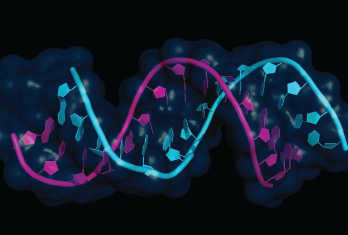
petarg / shutterstock.com
Researchers working to decode the epigenetic landscape for rheumatoid arthritis (RA) were surprised to discover a connection to Huntington’s disease, a finding that could pave the way to discoveries of new therapeutic targets.
By developing new methods to integrate data from epigenetic technologies, scientists at the University of California, San Diego (UCSD), set out to map the epigenome of rheumatoid arthritis and discovered potential, non-obvious biological targets for treatment of the disease. The findings were published in the May issue of Nature Communications.1
“We were most interested in identifying disease mechanisms that were not predictable, creating the opportunity to understand disease in a way that could not have been gleaned from simply looking at published reports,” says Gary S. Firestein, MD, dean and associate vice chancellor of translational medicine at UCSD.
Epigenetics is the study of DNA modifications that alter the genome without a change to DNA sequence; this process is responsible for some of the fine-tuning of gene expression, explains Dr. Firestein. Changes in the epigenome can help determine which genes are turned on or off and can be triggered by a variety of environmental elements, such as stress, physical activity and lifestyle choices.
Although epigenetic function is part of normal human growth and development, it can also go badly wrong and, ultimately, cause diseases, such as cancer, or contribute to the pathogenesis of diseases, such as in rheumatoid arthritis, says Dr. Firestein. “The changes that occur with rheumatologic diseases are much more subtle than cancer,” he says. “Generally, we are talking about relatively modest changes that just tweak cell behavior.”
Mapping the Epigenomic Landscape of RA

Dr. Firestein
Dr. Firestein and his team of researchers investigated the fibroblast-like cells that line the joints of patients with rheumatoid arthritis as well as those of osteoarthritis patients who served as a control group. To begin the process of mapping the epigenomic landscape of RA, they analyzed 191 data sets through examination and measurement of chromatin, DNA and histone modifications from both RA and osteoarthritis patients.
To maximize the potential for identifying differences in RA, researchers used cells from patients with late-stage disease. They focused on isolated cells collected at the time of surgery from the tissue of people who had total joint replacement.
“We fully profiled key epigenetic marks in RA patients and compared them to individuals who did not have this disease,” says Dr. Firestein. “As a control, for example, we used osteoarthritis because that is not generally considered an autoimmune disease.”
Changes in the epigenome can help determine which genes are turned on or off & can be triggered by a variety of environmental elements, such as stress, physical activity & lifestyle choices.
Moving Away from Inherent Biases
The results produced 12 terabytes of data for further analysis using the novel method developed by the researchers’ computational team, led by UCSD’s Wei Wang, PhD, professor of chemistry, biochemistry, and cellular and molecular medicine. That platform was designed to integrate and reduce the number of epigenetic combinations in the genes of patients with RA, opening the door to discovery of new cell signaling pathways, says Dr. Firestein.
“Dr. Wang and his colleagues developed an algorithm that allowed us to take multiple ways of looking at epigenetic marks and combine them into a single snapshot,” says Dr. Firestein, noting the platform provides a way to investigate disease pathogenesis in an unbiased manner and without preconceived notions of data types that are otherwise difficult to analyze together.
“We had a completely open mind in terms of what genes, pathways and targets we might identify,” says Dr. Firestein. “We allowed computationally determined pathways to emerge and determined which are most likely to be involved in RA. We then, of course, have to biologically validate the genes and pathways. That process is quite different from the inductive logic that is commonly used in research, where you read the literature, think about a project and then ascertain what the next logical step might be.
“That approach, by the way, can be exceptionally valuable and has led to many breakthrough therapies,” adds Dr. Firestein. “However, our view was that breakthroughs in the future would require moving away from some of those inherent biases and learning what could not be predicted from reading the literature.”
Finding the Huntington’s Disease Overlap
Many unexpected pathways emerged from the analysis, says Dr. Firestein. The most prominent among them was an apparent overlap with Huntington’s disease.
“We found that overlap particularly striking,” he says. “Almost no matter how we analyzed the data, the Huntington’s disease pathway almost always emerged as the top difference between rheumatoid arthritis and non-rheumatoid arthritis.”
The research identified a pathway overlap of the gene Huntington-interacting protein-1 (HIP1) and RA. The protein is known to regulate cancer cells, but its potential role had not been explored in inflammatory diseases, according to the article.
“We were able to show that interfering with the expression of that gene (HIP1) made cells from the disease joints in RA much less aggressive,” says Dr. Firestein. “This provided some biologic validation and suggests that the pathway and the genes within the pathway could be targeted to treat rheumatoid arthritis and possibly Huntington’s disease.”
Huntington’s disease is a terminal neurodegenerative disease of the brain and differs greatly from RA, an autoimmune-disorder marked by chronic inflammation. However, the overlap in the disease pathways could lead to new discoveries to treat both diseases, notes Dr. Firestein.
“Rheumatoid arthritis and Huntington’s disease are obviously very different diseases that involve distinct clinical manifestations and different types of cells. But the data implicate similar mechanisms in both,” he says.
Mapping the epigenome in RA was a key result of the research that led to the unexpected finding of a connection between two seemingly unrelated diseases, notes Dr. Firestein. The unbiased approach was not restricted by any presumption for the pathogenesis or mechanisms of disease.
Dr. Firestein says he believes the research findings create an opportunity to begin drug discovery programs that can uncover some new, unanticipated targets and further investigate potential therapy for RA in drugs designed to treat other unrelated diseases.
“In the longer term, we believe this is really the future for how we will begin to identify not only mechanisms in rheumatoid arthritis but in multiple other diseases,” he says.
Catherine Kolonko is a medical writer based in Oregon.
Reference
- Ai R, Laragione T, Hammaker D, et al. Comprehensive epigenetic landscape of rheumatoid arthritis fibroblast-like synoviocytes. Nat Commun. 2018 May 15;9(1):1921.

